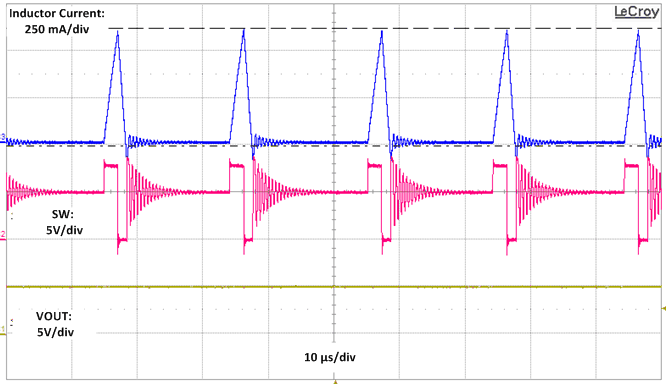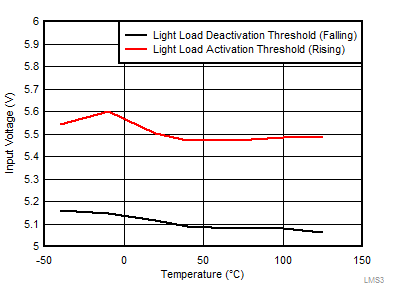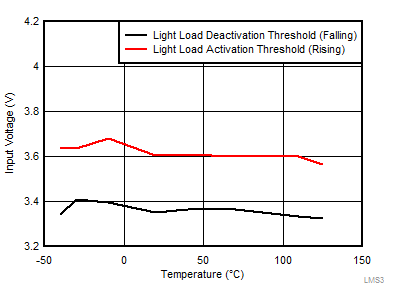ZHCSGY9B July 2017 – March 2018 LMS3655
PRODUCTION DATA.
- 1 特性
- 2 应用
- 3 说明
- 4 修订历史记录
- 5 Device Comparison Table
- 6 Pin Configuration and Functions
- 7 Specifications
- 8 Detailed Description
-
9 Application and Implementation
- 9.1 Application Information
- 9.2
Typical Applications
- 9.2.1 General Application
- 9.2.2 Adjustable 5-V Output
- 9.2.3 Adjustable 3.3-V Output
- 9.2.4 6-V Adjustable Output
- 9.3 Do's and Don't's
- 10Power Supply Recommendations
- 11Layout
- 12器件和文档支持
- 13机械、封装和可订购信息
8.4.1 AUTO Mode
In AUTO mode the device moves between PWM and PFM as the load changes. At light loads, the regulator operates in PFM. At higher loads, the mode changes to PWM. The load currents at which the mode changes can be found in the Application Curves.
In PWM, the converter operates as a constant frequency, current mode, full synchronous converter using PWM to regulate the output voltage. While operating in this mode the output voltage is regulated by switching at a constant frequency and modulating the duty cycle to control the power to the load. This provides excellent line and load regulation and low output voltage ripple. When in PWM, the converter synchronizes to any valid clock signal on the SYNC input (seeSynchronizing Input); during PFM operation, the SYNC input is ignored.
In PFM, the high-side FET is turned on in a burst of one or more cycles to provide energy to the load. The frequency of these bursts is adjusted to regulate the output, while diode emulation is used to maximize efficiency (see the Glossary). This mode provides high light-load efficiency by reducing the amount of input supply current required to regulate the output voltage at small loads. A small increase in the output voltage occurs in PFM. This trades off very good light load efficiency for larger output voltage ripple and variable switching frequency. The actual switching frequency and output voltage ripple depend on the input voltage, output voltage, and load. See the Application Curves for output voltage variation in AUTO mode. A typical switching waveform for PFM is shown in Figure 15.
A unique feature of this device is that a minimum input voltage is required for the regulator to switch from PWM to PFM at light load. This feature is a consequence of the advanced architecture employed to provide high efficiency at light loads. Figure 16 indicates typical values of input voltage required to switch modes at no load. Also, once the regulator switches to PFM at light load, it remains in that mode if the input voltage is reduced.
SPACE
 Figure 15. Typical PFM Switching Waveforms
Figure 15. Typical PFM Switching Waveforms
 Figure 17. Input Voltage for Mode Change — 5-V Output, 10-µH Inductor
Figure 17. Input Voltage for Mode Change — 5-V Output, 10-µH Inductor
 Figure 16. Input Voltage for Mode Change — 3.3-V Output, 10-µH Inductor
Figure 16. Input Voltage for Mode Change — 3.3-V Output, 10-µH Inductor